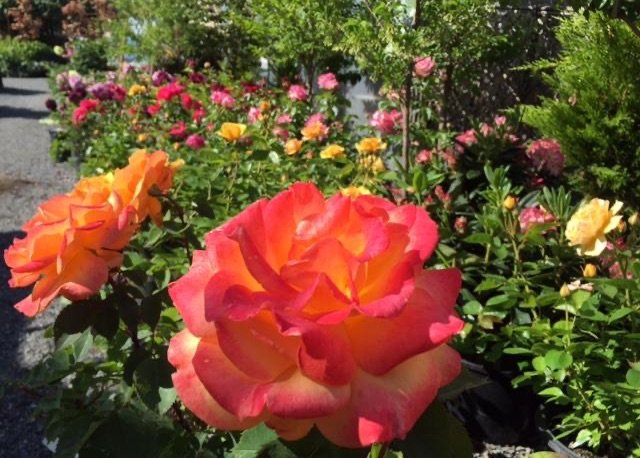It’s February and love is in the air. For a plant enthusiast, nothing personifies love more than a rose, or better yet, a rose garden. Those delectable blooms and exquisite fragrances are the consummate flower to have growing in our gardens where they will treat us to a summer-long feast of perfumed delights and glorious arrangements of multi-colored flowers. There is a reason roses are considered the queen of flowers. Royalty begets them. And now is the time to plant them!
There are oodles of rose growing guides available, not to mention an easy to follow one on our website, so I won’t go into great detail about how to make these beauties happy. Plant them in full sun with good soil, feed them generously and stay on top of any diseases and insects that pop up, and you should be able to reap a continuous supply of flowers. As long as you keep them well fed and remove the spent flowers before they go to seed, they will continue to bloom. It’s that simple.
Probably the most challenging thing about roses is deciding which ones to grow. We have literally thousands of roses at our garden center this time of year. Narrowing your choices down is a function of color preferences, fragrance, disease resistance, and growing habits. Fortunately, all of these traits are usually visibly displayed on the label, so there is not a lot of guess work. At the nursery we organize our roses into several categories…
Climbers obviously are designed to clamor over a fence or trellis and the flowers are usually on the smaller side. While they are not really vining, they do send out long woody branches that are suitable for training over structures. Three classic climbing rose varieties are ‘Don Juan’ with deep velvety red fragrant flowers, ‘Joseph’s Coat’ with multi-colored, lightly fragrant blooms, and ‘Sally Holmes’, which boasts large clusters of single flowers turning from apricot to white to rose.
Floribundas are smaller, shrubbier plants, usually growing 3 to 4 feet tall with clusters of flowers (think of an “abundance of flowers”). ‘Sunsprite’ is a classic bright yellow with a strong, sweet licorice smell (and one of the first to bloom in the garden). ‘Forever Amber’ is a new apricot colored variety with a fruity fragrance and ‘Sweet Madame Blue’ is another new variety with lavender flowers and strong spicy citrus fragrance.
Grandifloras are larger plants (5 to 6 feet tall) with clusters of large flowers (think “grand flowers”). ‘Queen Elizabeth’ is by far the classic grandiflora with its large clusters of clear pink flowers. A new variety for 2022 is ‘Pop Art’, sporting pink and yellow striped blooms with a strong fruity citrus aroma. These are vigorous plants, so give them plenty of room to grow.
David Austin roses are newer varieties of the classic old English roses of yore with their high petal count and mostly yummy fragrances. These have been in short supply in recent years but we were able to obtain a couple dozen varieties for 2022. These are lovely roses for the cottage garden.
Finally, the largest group of roses fall into the category of hybrid teas. These are what most people think of when they grow roses. Old standbys include ‘Mister Lincoln’ with its velvety red blooms and damask rose fragrance, ‘Peace’ with its lemon-yellow, edged pink blooms, and fruity fragrance, and ‘Just Joey’ with its rich apricot blooms and fruity fragrance. New for 2022 is ‘Chantilly Cream’ which boasts soft-butter-yellow blooms and sweet citrus fragrance.
For Valentine’s Day this year, share the love for your favorite gardener with a new rose. It will be the gift that just keeps on giving. Stay safe and keep on gardening!





